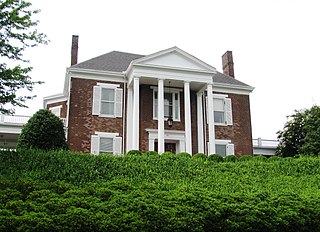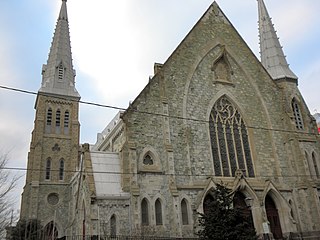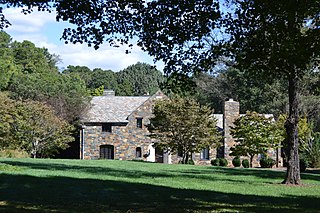
Manassas National Battlefield Park is a unit of the National Park Service located in Prince William County, Virginia, north of Manassas that preserves the site of two major American Civil War battles: the First Battle of Bull Run, also called the First Battle of Manassas, and the Second Battle of Bull Run or Second Battle of Manassas. It was also where Confederate General Thomas J. Jackson acquired his nickname "Stonewall". The park was established in 1936 and listed on the National Register of Historic Places on October 15, 1966.

Rhodes Memorial Hall, commonly known as Rhodes Hall, is an historic house located in Atlanta, Georgia, United States. It was built as the home of furniture magnate Amos Giles Rhodes, proprietor of Atlanta-based Rhodes Furniture. The Romanesque Revival house occupies a prominent location on Peachtree Street, the main street of Atlanta, and is listed in the National Register of Historic Places. It is open to the public and has been the home of The Georgia Trust for Historic Preservation since 1983.

Edgewood Plantation is an estate located north of the James River in Charles City County, Virginia. It is located along State Route 5, a scenic byway which runs between the independent cities of Richmond and Williamsburg. Edgewood was listed on the National Register of Historic Places in 1982.

Knollwood is an antebellum historic house at 6411 Kingston Pike in Knoxville, Tennessee, United States. It is also known as Knollwood Hall, Major Reynolds House, the Tucker Mansion and Bearden Hill. The home is listed on the National Register of Historic Places.

The James Whitcomb Riley Museum Home, one of two homes known as the James Whitcomb Riley House on the National Register of Historic Places, is a historic building in the Lockerbie Square Historic District of Indianapolis, Indiana. It was named a National Historic Landmark in 1962 for its association with poet James Whitcomb Riley (1849-1916), known as the "Hoosier poet".

The Senate House State Historic Site is located on Fair Street in Kingston, New York, United States. During the Revolutionary War, New York's First Constitutional Convention met there and on April 20, 1777, adopted the first New York State Constitution. After one month, the Senate fled the British troops who were advancing from Manhattan. The Senate House and much of Kingston was burned in retribution. It has served as a museum from the late 19th century. Currently it is owned and operated by the New York State Office of Parks, Recreation and Historic Preservation.

The Reynolds-Morris House is a historic house at 225 South 8th Street in the Washington Square West neighborhood of Philadelphia, Pennsylvania. Built in 1786–87 by John and William Reynolds, it is a well-preserved example of a Philadelphia Georgian townhouse. It was designated a National Historic Landmark in 1967, and is currently operated as a hotel.

Bentonville Battlefield is a North Carolina state historic site at 5466 Harper House Road in Johnston County, North Carolina. It belongs to the North Carolina Department of Natural and Cultural Resources and is the site of the 1865 Battle of Bentonville, fought in the waning days of the American Civil War. It was declared a National Historic Landmark in 1996.

This is a list of the National Register of Historic Places listings in Dakota County, Minnesota. It is intended to be a complete list of the properties and districts on the National Register of Historic Places in Dakota County, Minnesota, United States. Dakota County is located in the southeastern part of the U.S. state of Minnesota, bounded on the northeast side by the Upper Mississippi River and on the northwest by the Minnesota River. The locations of National Register properties and districts for which the latitude and longitude coordinates are included below, may be seen in an online map.

The Montford Area Historic District is a mainly residential neighborhood in Asheville, North Carolina that is included in the National Register of Historic Places.

The Peyton Randolph House, also known as the Randolph-Peachy House, is a historic house museum in Colonial Williamsburg, Virginia. Its oldest portion dating to about 1715, it is one of the museum's oldest surviving buildings. It was designated a National Historic Landmark in 1973 as the home of Peyton Randolph (1721–1775), first President of the Continental Congress.

The Reynolds Homestead, also known as Rock Spring Plantation, is a slave plantation turned historical site on Homestead Lane in Critz, Virginia. First developed in 1814 by slaveowner Abraham Reynolds, it was the primary home of R. J. Reynolds (1850-1918), slaveowner, founder of the R. J. Reynolds Tobacco Company, and the first major marketer of the cigarette. Upon liberation of the plantation in 1863, 88 people were freed from captivity and enslavement. It was later designated a National Historic Landmark in 1977. The homestead is currently an outreach facility of Virginia Tech, serving as a regional cultural center. The house is open for tours.

Grace United Methodist Church is a historic Methodist church located at 9th and West Streets in Wilmington, New Castle County, Delaware. It was designed by architect Thomas Dixon and built in 1868. It is constructed of serpentine stone of a light pea green color in the Victorian Gothic style. The church building measures approximately 166 feet by 102 feet, 6 inches. It features a needle spire that rises to 186 feet and is topped by a Celtic cross.

The U.S. Courthouse and Post Office in Aberdeen, Mississippi was built in 1885. Also known as Old Federal Building, it served historically as a courthouse and as a post office. It was listed on the National Register of Historic Places in 1976.

Canterbury Castle, also known as Arlington Castle, was a private house located in southwest Portland, Oregon and listed on the National Register of Historic Places. Constructed during 1929–1931, the house was designed by Jeter O. Frye to resemble England's Canterbury Castle on the exterior and to evoke the Art Deco styling of Hollywood of the 1920s on the interior. The house included castle features such as a moat, drawbridge and turret and attracted paying tourists immediately following its completion.

James Armor House is a historic home located near Wilmington, New Castle County, Delaware. It is a 2+1⁄2-story, stuccoed stone and frame dwelling that was constructed in three major building phases. It consists of a two-story stone rear wing dating to about 1804, a 2+1⁄2-story vernacular Italianate style stone main block built about 1850, and two-story Colonial Revival style frame wing built in the 1930s. Also on the property is a contributing garage/workshop built in the 1930s.

The Hugh Wilson Hill House, also known as the Kelly-Stone-Hill House, is a historic house in Carrollton, Pickens County, Alabama. It is one of only a few surviving antebellum structures remaining in the town. Architectural historians believe that the one-story Greek Revival-style house was built for Isham and Elizabeth Kelly during the late 1830s or 1840s. Confederate general John Herbert Kelly grew up in the house. It was added to the National Register of Historic Places on April 13, 1989. It was listed as one of Alabama's "Places in Peril" for 2010 by the Alabama Historical Commission and Alabama Trust for Historic Preservation.

James B. and Diana M. Dyer House is a historic home located at Winston-Salem, Forsyth County, North Carolina. It was built in 1931, and is a large one- and two-story, irregularly-massed, Tudor Revival style dwelling with a rough-cut-stone exterior. It has a green slate roof, stepped stone chimney, and metal casement windows. It was built for James Dyer, a top executive at R. J. Reynolds Tobacco Company.

The First Battle of Newtonia Historic District, near Newtonia, Missouri, is a National Register of Historic Places (NRHP) site that preserves the location of the First Battle of Newtonia, an 1862 battle during the American Civil War. The battle saw Confederate troops under Colonels Douglas H. Cooper and Joseph O. Shelby defeat a Union force commanded by Brigadier General Frederick Salomon. The historic district contains some Civil War-period structures, as well as the Mathew H. Ritchey House, which is listed separately on the NRHP.





















